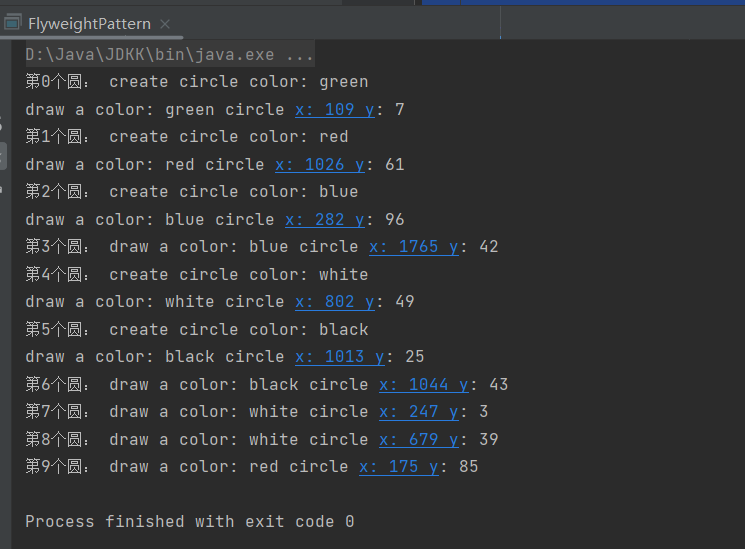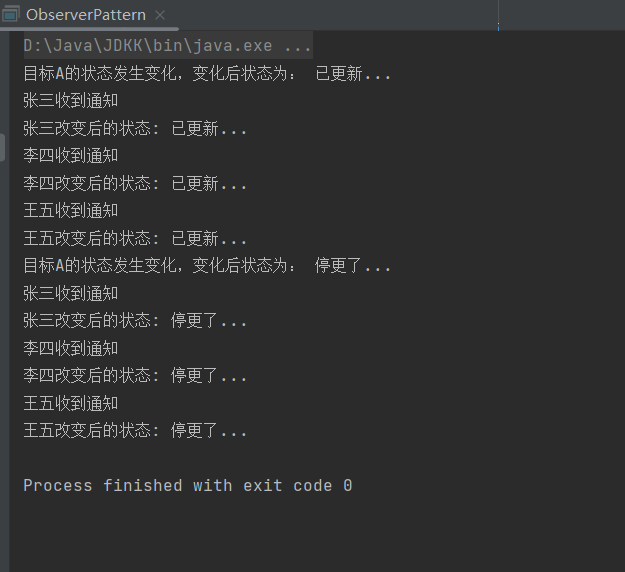1.Decorator装饰器模式

示例代码:
package Decorator09;
/**
* 装饰器模式
* 意图:动态的给一个对象添加一些额外的职责。
* 适用性:
* 在不影响其他对象的情况下,以动态、透明的方式给单个对象添加职责
* 处理那些可以撤销的职责
*/
public class DecoratorPattern {
public static void main(String[] args) {
Person zhangsan = new Student("张三");
zhangsan.Operation();
System.out.println("--------------------");
// DecoratorA decoratorA = new DecoratorA(zhangsan);
// Person zhangsan = new DecoratorA(zhangsan);
zhangsan = new DecoratorA(zhangsan);
zhangsan.Operation();
System.out.println("--------------------");
zhangsan = new DecoratorB(zhangsan);
zhangsan.Operation();
}
}
//Component
abstract class Person{
protected String name;
public abstract void Operation();
}
//ConcreteComponent
class Student extends Person{
public Student(String name){
this.name=name;
}
@Override
public void Operation() {
//职责方法
System.out.println(name+"的职责:学习");
}
}
//Decorator
abstract class Decorator extends Person{
protected Person person;
}
class DecoratorA extends Decorator{
public DecoratorA(Person person){
this.person = person;
}
@Override
public void Operation() {
//职责方法
person.Operation();//原先的职责
System.out.println("新增职责:扫地");//新增职责
}
}
class DecoratorB extends Decorator{
public DecoratorB(Person person){
this.person = person;
}
@Override
public void Operation() {
//职责方法
person.Operation();//原先的职责
System.out.println("新增职责:唱歌");//新增职责
}
}
2.Flyweight享元模式

示例代码:
package Flyweight10;
/**
* 享元模式
* 意图:运用共享技术有效地支持大量细粒度的对象
*
*/
public class Flyweight {
public static void main(String[] args) {
PieceFactory pieceFactory = new PieceFactory();
//白棋
Piece whitePiece1 = pieceFactory.getPiece(0);
whitePiece1.draw(1,3);
}
}
class PieceFactory{
private Piece[] pieces = {new WhitePiece(),new BlackPiece()};
public Piece getPiece(int key){
if(key==0) return pieces[0];
else return pieces[1];
}
}
abstract class Piece{
protected String color;
public abstract void draw(int x,int y);
}
class WhitePiece extends Piece{
public WhitePiece(){
this.color="white";
}
@Override
public void draw(int x, int y) {
System.out.println("draw a color: "+color+"piece x: "+x+"y: "+y);
}
}
class BlackPiece extends Piece{
public BlackPiece(){
this.color = "black";
}
@Override
public void draw(int x, int y) {
System.out.println("draw a color: "+color+"piece x: "+x+"y: "+y);
}
}

package Flyweight10_2;
import java.util.HashMap;
import java.util.Map;
import java.util.Random;
public class FlyweightPattern {
public static void main(String[] args) {
ShapeFactory factory = new ShapeFactory();
Random random = new Random();
String[] colors = {"red","blue","green","white","black"};
for(int i=0;i<10;i++){
System.out.print("第"+i+"个圆: ");
int x = random.nextInt(colors.length);
Shape shape = factory.getShap(colors[x]);
shape.draw(random.nextInt(2022),random.nextInt(100));
}
}
}
//FlyweightFactory
class ShapeFactory{
private Map<String ,Shape> map = new HashMap<>();
public Shape getShap(String key){
if(map.containsKey(key)){
return map.get(key);
}else {
Shape shape = new Circle(key);
map.put(key, shape);
return shape;
}
}
}
//Flyweight
abstract class Shape{
protected String color;
public abstract void draw(int x,int y);
}
//ConcreteFlyweight
class Circle extends Shape{
public Circle(String color){
System.out.println("create circle color: "+ color);
this.color = color;
}
@Override
public void draw(int x, int y) {
System.out.println("draw a color: "+color+" circle x: "+x+" y: "+y);
}
}

3.Command命令模式

示例代码:
package Command11;
/**
* 命令模式:
* 意图:将一个请求封装为对象,从而使得可以用不同的请求对客户进行参数化,对请求排队或记录请求日志,以及支持可撤销的操作。
* 适用于:
* 抽象出待执行的动作以参数化某对象
* 在不同时刻指定、排列和执行请求
* 支持取消操作
* 支持修改日志
* 用构建在原语操作上的高层操作构造一个系统
*/
public class CommandPattern {
public static void main(String[] args) {
Tv tv = new Tv();//接收者
Command onCommand = new OnCommand(tv);//命令对象 开机命令
Command offCommand = new OffCommand(tv);//命令对象 关机命令
Invoker invoker = new Invoker();//请求者
invoker.setCommand(onCommand);//请求者设置开机命令
invoker.call();//请求者请求命令
System.out.println("--------------------");
invoker.setCommand(offCommand);//请求者设置关机命令
invoker.call();//请求者请求命令
}
}
//请求者:执行命令
class Invoker{
private Command command;
public void setCommand(Command command){
this.command = command;
}
public void call(){
//调用
command.Execute();
}
}
interface Command{
public void Execute();
}
class OnCommand implements Command{
private Tv tv;
public OnCommand(Tv tv){
this.tv = tv;
}
@Override
public void Execute() {
tv.OnAction();
}
}
class OffCommand implements Command{
private Tv tv;
public OffCommand(Tv tv){
this.tv = tv;
}
@Override
public void Execute() {
tv.OffAction();
}
}
//Receiver
class Tv {
public void OnAction(){
System.out.println("开机...");
}
public void OffAction(){
System.out.println("关机...");
}
}

4.Observer观察者模式

示例代码:
package Observer12;
import java.util.ArrayList;
import java.util.List;
/**
* 观察者模式:
* 意图: 定义对象间的一种一对多的依赖关系,当一个对象的状态发生改变时,所有依赖于它的对象都得到通知并被自动更新
* 适用于:
* 当一个对象的改变需要同时改变其他对象,而且不知道有多少个对象有待改变
*/
public class ObserverPattern {
public static void main(String[] args) {
Subject subjectA = new ConcreteSubject("目标A");
Observer observerB = new ConcreteObserver("张三",subjectA);
Observer observerC = new ConcreteObserver("李四",subjectA);
Observer observerD = new ConcreteObserver("王五",subjectA);
// System.out.println("目标A的状态改变后...");
subjectA.setState("已更新...");
// subjectA.Notify();
subjectA.setState("停更了...");
}
}
//目标接口
interface Subject{
public void Attach(Observer observer);
public void Detach(Observer observer);
//状态改变后,通知所有观察者
public void Notify();
public void setState(String state);
public String getState();
}
class ConcreteSubject implements Subject{
private String name;
private String state;
private List<Observer> observerList;
public ConcreteSubject(String name){
this.name=name;
state="未更新";
observerList = new ArrayList<Observer>();
}
@Override
public void Attach(Observer observer) {
observerList.add(observer);
}
@Override
public void Detach(Observer observer) {
observerList.remove(observer);
}
@Override
public void Notify() {
for (Observer observer: observerList) {
observer.update();
}
}
@Override
public void setState(String state) {
this.state=state;
System.out.println(name+"的状态发生变化,变化后状态为: "+state);
Notify();
}
@Override
public String getState() {
return this.state;
}
}
//观察者接口
interface Observer{
public void update();
}
class ConcreteObserver implements Observer{
private String state;
private String name;
//指明目标
private Subject subject;
public ConcreteObserver(String name,Subject subject){
this.state=subject.getState();
this.name=name;
this.subject = subject;
subject.Attach(this);
}
@Override
public void update() {
System.out.println(name+"收到通知");
state = subject.getState();
System.out.println(name+"改变后的状态: "+state);
}
}











